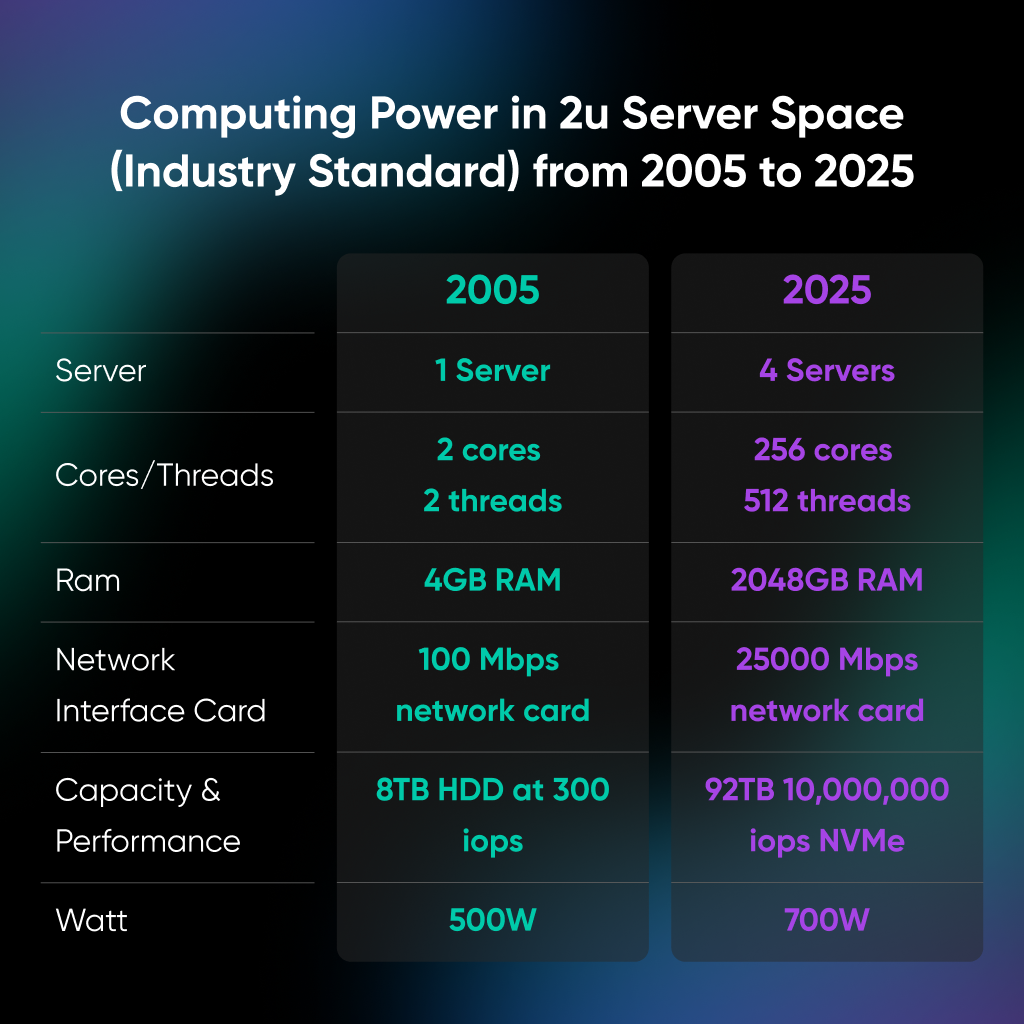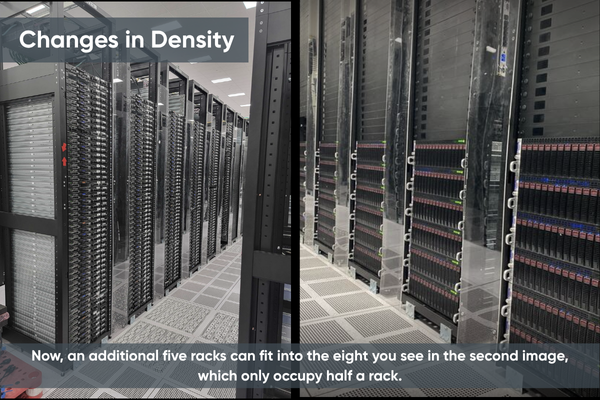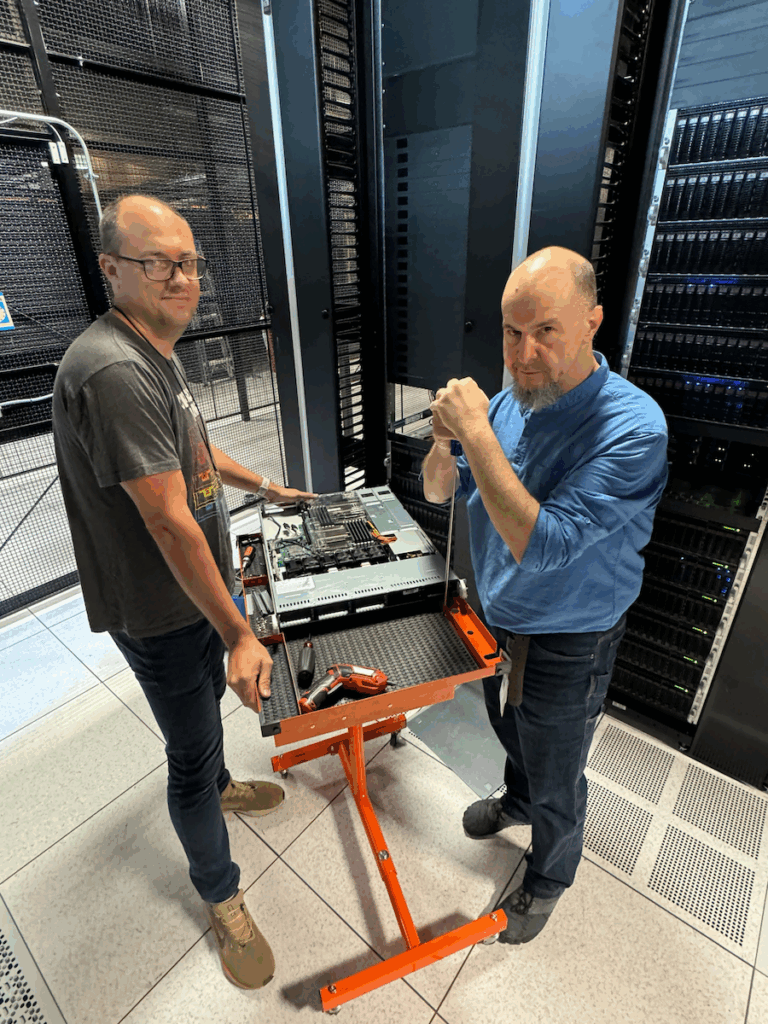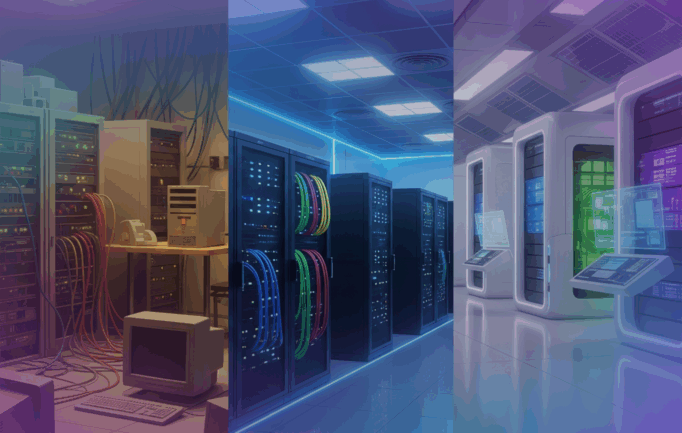Though the internet often feels like magic, it runs on racks, wires, blinking lights, and the dedicated humans who keep it online at 3 a.m.
At DreamHost, our infrastructure team doesn’t just “keep the lights on,” they keep over a million websites secure and scalable. But how do you evolve from pizza box servers and USB installs to high-density racks humming with virtual machines?
Let’s lift the lid on infrastructure—past, present, and future—and look at what really makes it tick (and where it’s headed, ready or not).
The Present: Where Human Creativity and Hardware Collide
The Humans Behind the Machines
Infrastructure at DreamHost is a complex dance of hardware, software, and hands-on expertise. “We keep the internet running,” says Chris Lewis, Manager of Data Center Operations. Whether it’s midnight fire drills or firmware upgrades, the team stays invisible until they’re the most important people in the room.
Luke Odom, Director of IT Operations, brings 15 years of experience. Chris, who previously worked at Amazon and Yahoo, was drawn back by the hum of fans and the scent of filtered air. Together, they represent the balance of continuity and innovation that powers DreamHost today.

The Daily Grind: From Fire Drills to Firmware
The team’s day starts with Slack, dashboards, and hardware scans. Tasks range from RAID rebuilds to prepping racks for deployments. Even with increasing automation tools, hands-on work is still essential.
“Some things you just can’t do from your couch,” Chris says. Tragically for him, this includes swapping failed hard drives or untangling mystery cables.
The Data Center Experience: Sounds, Senses, and Strategy
DreamHost’s data centers are sensory overload. Cold aisles blast air at 37°F; hot aisles can reach 120°F. “You don’t live on the floor,” Chris says. “You run in, do what you need, and get out.”
The hum of thousands of fans is constant, like standing inside a whispering jet engine. But amid the noise, there’s beauty. Chris likens blinking server lights to stars, each one a connection. “That’s someone saying, ‘I want you to see this,’ and someone else reaching back to say, ‘I see it.’”
The Past: How Infrastructure Used to Be
Lower Density, Higher Effort
In the early 2000s, 15 servers per rack supported 100 customers each. Today, a single rack can host 48 servers, each serving 2,500+. That’s not just growth, it’s transformation.

Hardware Generations
Processors have gone from dual CPUs with four cores to single CPUs with 128 threads. Spinning 80GB drives have been replaced by 12TB NVMe SSDs, all in the same physical space.
Think of it like your upgraded phone: same size, massively more powerful. DreamHost can now do a lot more work and store a lot more information, much faster than before.
Manual Installs and Elbow Grease
Luke remembers the “stick install” era: walking rack to rack with a USB stick, stepping through memorized keystrokes. Now, with OpenStack automation, hundreds of servers deploy in minutes.
Did You Know? In the early 2000s, some installs took so long that techs would leave notes taped to the machine: “Come back in 2 hours—still rebooting.”
It wasn’t elegant, but it worked. And it paved the way for the systems we rely on today.
The Future: Smarter, Cooler, and (Maybe) Underwater
Smarter, Not Just Denser
According to Luke and Chris, the future of infrastructure isn’t just about stacking higher, it’s about getting smarter.
“The next evolution isn’t necessarily more density, but more smart density, such as increasing per-watt performance, better workload scheduling, and liquid cooling adoption to manage heat profiles,” Luke says.
That means putting more focus on the efficiency of infrastructure: managing heat, power draw, and how well we use the hardware we already have.

Sustainability Through Innovation
With rising power needs, sustainability is key. Chris highlights bold experiments, like Microsoft using AI to reopen the Three Mile Island to power its data centers. “Even with scary technologies like nuclear, the need for power should drive tech toward cleaner, cheaper offerings,” he says.
Luke adds that waste heat may be a resource, not a problem, “Datacenters use a lot of power and much of that becomes heat. Many novel sustainability practices are around utilizing that heat.”
Containers: Still Evolving, Just Smarter
Containerization has been one of the biggest shifts in infrastructure, and it’s far from done. For Chris and Luke, the future of containers isn’t about replacing them, but deepening their usefulness.
“We want to use as much of the processing capacity of a server as possible,” Chris says. “The easy way to do that is to get more containers to do more things.”
With the stable platform, Dreamhost is building on it: smarter deployments, better scaling, and automated recovery.
“We’ve got a great containerization platform created and can start building on top of that,” Luke adds.
Human-Aided Automation
DreamHost has embraced automation where it adds value, particularly in provisioning and configuration, but many tasks still require the human touch, creativity and problem-solving. “We’re moving toward plug-and-play,” says Lewis, “but it still takes people to support it.”
Infra Dream: Chris dreams of a robot that handles RMAs and e-waste. Luke just wants a bot to cable things correctly. Still, someone has to fix the robot when it breaks.
Infrastructure, Anywhere and Everywhere
Underwater, in space, or at the edge, physical infrastructure is expanding into surprising places.
“There already are underwater data centers. The International Space Station is 100% infrastructure,” Chris notes.
DreamHost may not be building ocean-floor pods yet, but edge caching and distributed infrastructure are already happening, and likely to grow.
“We’ll go where our customers take us,” Chris says. “If that’s to the moon, we’ll get there.”
Skills for Tomorrow… Plumbing, Maybe?
With technologies like liquid cooling gaining traction, infrastructure engineers will need new skills. “What skills might they learn that I didn’t when I started? Plumbing and fluid dynamics. Probably how to mop too,” Chris jokes.
Thermal management is now part of the job. Designing systems that cool efficiently, and safely, will be crucial.

A Glimpse at 2040
So what might a DreamHost data center look like in 2040? According to Chris, it might involve neurolinks and remote-controlled robot spiders, but more realistically, it means a world of redundancy and near-instant failover.
“Almost the entirety of our gear will be supporting huge room-sized clusters where individual machines can be lost and replaced without interrupting service.”
It’s starting now at the hyperscale level, but Luke sees that tech trickling down. Soon, even smaller providers may run “self-healing” setups once only available to the Googles of the world.
What Should Never Change
Through all this evolution, one thing remains: infrastructure is powered by the people. “Infrastructure isn’t about the machines. It’s about the team and the people,” Luke emphasizes.
“Anyone grabbing a bucket when the fire hits is a friend,” Chris adds.
Technologies will change. The mission will grow. But the camaraderie, the curiosity, and the 3 a.m. alert responses? That’s the heart of DreamHost infrastructure. It’s built to last even if the robots show up.
Coming Soon: In the final part of this series, we go behind the scenes with stories from the trenches: late-night fixes, unsung wins, and the humans who keep the servers flowing.
